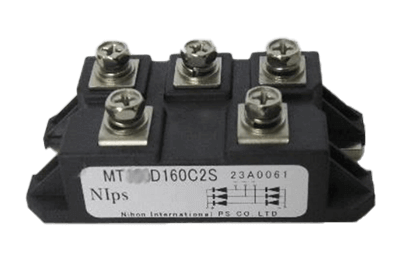What Is a Diode Module?

A diode module is a semiconductor rectifier device that controls the conduction and interruption of electricity by arranging multiple diodes.
Diode modules have the characteristic of being able to control the flow of current in only one direction in an electric circuit, and are generally incorporated as relay components in circuit design.
Elements with similar behavior include thyristors and triacs. Depending on the process you wish to implement, these modules are used in different ways.
Uses for Diode Modules
Diode modules are widely used components in industrial products.
The following are examples of applications of diode modules:
- Power source for DC motors
- Power supplies for inverters
- Control devices for battery charging and discharging
- Inside power supplies
Diodes are widely used inside DC power supplies because they allow current from an AC power supply to be taken out in only one direction. When used in conjunction with a smoothing capacitor, etc., AC current can be converted to DC current.
Principle of Diode Modules
To understand the principle of the diode module, it is necessary to understand the structure of a diode. The internal structure of a diode consists of alternating layers of n-type and p-type semiconductors, which conduct when voltage is applied from the anode side to the cathode side. On the other hand, when voltage is applied in the opposite direction, charge moves away from the internal n- and p-type semiconductors, resulting in no current flow.
Using this characteristic, the diode can be used as a graded-grain element in which electricity flows in one direction.
Types of Diode Modules
There are various types of diodes depending on their properties.
1. Rectifying Diode
A diode that rectifies alternating current by allowing it to flow in. They are also called silicon diodes. They are used in power supply circuits and protection circuits by taking advantage of the property that electricity flows in only one direction.
A well-known example is a diode bridge that combines four rectifier diodes.
2. Detector Diode
A diode that extracts audio signals from radio waves by taking advantage of its low forward voltage drop in the low current range (around 0.1 mA). They are used for voice communications, such as radios.
In the past, germanium diodes were often used. However, they are now being replaced by Schottky barrier diodes due to their extremely high cost.
3. Constant Voltage Diode
A diode whose voltage remains constant even when the current changes. Also called a Zener diode. They are used in over-voltage protection circuits by utilizing the Zener phenomenon, in which electricity flows at a constant voltage when voltage is applied in the reverse direction.
4. Photodiode
A photodiode that utilizes the property of light at the PN junction to generate an electric current and voltage. They are used in photoelectric sensors and optical communications.
They are sometimes used in solar cells, in devices that read laser light reflected from uneven surfaces on DVDs, and in the receiving part of TV remote controls.
5. Constant-Current Diode
A diode that conducts a constant current when the voltage is within a predetermined range. Applying a voltage higher than a predetermined level may damage the diode. They are used in battery charging/discharging circuits and ground-fault circuit breakers.
Other Information on Diode Modules
1. Internal Structure of Thyristor
Thyristor is a semiconductor component with a gate electrode added to a Diode Module, which conducts when a positive bias is applied from the anode side to the cathode side in the circuit and a gate current flows.
Once gate current flows, the module maintains conduction until the next time the bias from the anode side to the cathode side becomes negative or the gate current becomes zero.
Also, thyristors will only conduct with a unidirectional bias. If you want to operate against bias in both directions, a triac with thyristors installed in both directions is used.
2. Difference Between a Diode Module and a Power Module
Like diode modules, power modules are used in power circuits. Power modules also perform switching and rectification, but they are used in products that require high voltage and high power.
A familiar example is an inverter that controls the speed of a motor in a railroad, for example. As a response to energy conservation, the improvement of the efficiency of power devices that handle high voltage and high power is attracting worldwide attention.